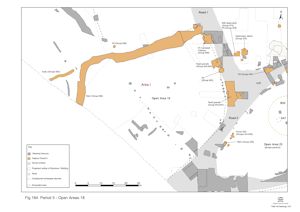
Open Area 18 is retained as a distinct land entity in the Late Roman period (Figure 184). Continued use of Roads 1 and 2 perpetuates its eastern and southern boundaries, while the boundary with the Northern Zone is renewed. The division between Central and Northern Zones is therefore clearly still of importance, in this part of the settlement at least.
Although much of the investigation of OA18 was admittedly concentrated alongside the roads, there appears to be little sign of occupation across its interior. Although some earlier features, such as disused well 12 (5806 Group 639 Period 4), continue to accumulate Late Roman material in their tops, no new structures or pits are evident. The Late Roman function of this enclosure is therefore undetermined.

Ditch 25027 (segs 10311, 10380, 10404, 10406, 10520, 10538, 10657, 10663) is a wide shallow linear feature that clearly both replaces and perpetuates the boundary between OA18 and the Northern Zone. The ditch is up to 4.6m wide though only 0.45m deep, with a vaguely rounded terminal at its east end that cuts the end of roadside ditch 25247 and the western edge of Road 1 itself. Traces of two re-cuts are evident in the vicinity of the terminal and, elsewhere along its length, the stepped sides of the cut make it likely that the ditch is cleaned or re-cut on at least four occasions. Although not unequivocally demonstrated by excavation, the western terminal can be confidently inferred, so establishing the ditch to be c. 38m in length in total.
This feature replaces the Period 4 Structure 42 fenceline (Group 822), truncating the tops of its clay-packed post-holes and overlying the remains of earlier ditch 25015 (Group 777 Period 3C). The precise date of the imposition of ditch 25027 remains unclear, as its surviving fills perhaps only relate to its latest use and subsequent disuse.
Its artefact assemblage is exceptional, comprising large amounts of Late Roman pottery, tile and an array of metalwork that includes jewellery items, working waste and apparent scrap fragments. Perhaps most significant is the large collection of copper-alloy coins from the east end of the ditch (particularly seg. 10406, but also 10520 and 10657). The latest coins date to AD 364-375, or 367-375, though most are from the early to mid-4th century. There are also a significant number of earlier coins, from the early 2nd century onwards. Two complete ceramic vessels and fragments of face-flagons are also present, and it seems apparent that at least part of the assemblage is the result of structured or votive deposition within the open feature - perhaps over a protracted period of time. Only a possible miniature copper-alloy hammer (SF5216) from ditch seg. 10539 can be identified as a purpose-made votive object. The remainder have more mundane primary functions - bracelets, finger ring, brooch, beads, coins, knife, weights. However, the presence of copper-alloy, iron and lead scrap, off-cuts and cast waste, and the higher than usual incidence of items such as quern, rubber and whetstone fragments, may be equally significant in this posited practice of ritual deposition of everyday items. The proximity of the east end of ditch 25027 to both the edge of Road 1 and the temple complex is likely to be relevant to the circumstance of their deposition.
Ditch 25031 (segs 9381, 9812) is a WSW-ENE aligned ditch c. 11m long (as exposed within Excavation Area D) and 1.35m wide. It overlies and runs within the confines of earlier ditches 25034 and 25035 (Groups 769 and 770, Period 3B). It has a rounded terminal at its eastern end and displays a minor kink or 'dog-leg' in its line, which seems to be a product of it straddling both earlier ditch lines.
The imposition of 25031 seems a deliberate act to re-establish the old boundary. However, this is not simply a reinstatement, but as much a modification of the boundary arrangement. The small gap between earlier ditches 25034 and 25035 is blocked and a much larger one (14m wide) seemingly established just to the east between its terminal and the west end of ditch 25027.
Perhaps more plausibly, some vestige of the boundary formally marked by Periods 3B-4 ditch 25015 may survive or be retained into Period 5 at this point, perhaps in the form of a hedge, thus perpetuating this corner of the OA18 enclosure.
Short, shallow and irregular ditch 25247 (segs 10290, 10525, 13239) is in some ways reminiscent of ditch 25027. Located along the edge of Road 1, it has been previously described as a roadside feature (see 'Roads 1 and 2') but could equally be regarded as an OA18 boundary. While its northern extreme is cut by the end of ditch 25027, their intersection is so slight that the two features could well function contemporaneously.
Although not as prolific, its artefact assemblage perhaps has some similarities with depositional activity in 25027. Along with a variety of iron strip, plate, bar, rod and nail fragments there is a silver denarius (SF3456), copper-alloy buckle fragment (SF5111) and an onyx intaglio (SF5109).
Internet Archaeology is an open access journal based in the Department of Archaeology, University of York. Except where otherwise noted, content from this work may be used under the terms of the Creative Commons Attribution 3.0 (CC BY) Unported licence, which permits unrestricted use, distribution, and reproduction in any medium, provided that attribution to the author(s), the title of the work, the Internet Archaeology journal and the relevant URL/DOI are given.
Terms and Conditions | Legal Statements | Privacy Policy | Cookies Policy | Citing Internet Archaeology
Internet Archaeology content is preserved for the long term with the Archaeology Data Service. Help sustain and support open access publication by donating to our Open Access Archaeology Fund.